#fun fact Friday
Text
Crab Fact: Crabs have teeth in their stomach that help them grind their food for digestion. Ghost crabs have been observed using these teeth to growl!
2K notes
·
View notes
Text
Fun Fact: Hognose snakes are dramatic lil guys!
I am particularly fond of the snakes known as hognose snakes, and my reasons are both understandable and correct.
This is a hognose snake:
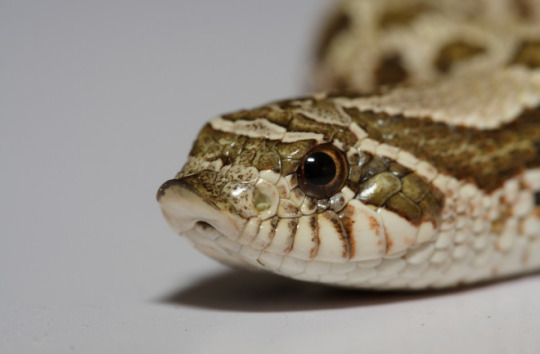
(They received their name by having the sweetest lil snoot to ever require a boop – image source)
They use these adorable snoots to burrow under sandy soil using a sort of nuzzle-y motion. They then use these burrows as a place to sleep at night, hibernate in the winter, and lay their eggs.

(you could say they’re into... the Underground Scene! ...ok yeah i’ll show myself out – image source)
Plus, they come in a variety of delightful colours!
We've got brown! Beige! Yellow! Black! Red! Orange! Tan! Kinda greenish! Orange again!

(pretty sneks! – Here’s all the image sources: 1, 2, 3, 4, 5, 6, 7, 8, 9)
And, to be clear, the snakes pictured above are wild snakes. No selective breeding by humans in these noodly bois! At least, not in these specific individuals. probably. I guess a few of them could be escapees...
But most importantly: These snakes know the true meaning of DRAMA
Hognose snakes are actors, first and foremost. When they feel threatened, the first thing they do is puff out their neck into a hood.
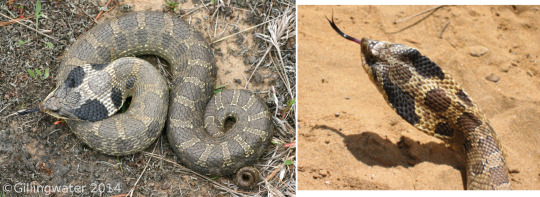
(like cobras, this hood is made by FLEXING THEIR NECK RIBS. which: gross – image source x)
This superficially makes them look like a cobra, but what they’re actually trying to do is make themselves seem bigger, and therefore scarier. Possibly those dark spots on their neck helps with that!
Any resemblance to real-life Eurasian cobras, real or fictional, is purely coincidental
Also, it makes its mouth do this:

(Snakes that SCREAAAAAAAM. – image source)
honestly, if I didn’t already know that hognose snakes were harmless, this would ABSOLUTELY make me leave it the hell alone
But if all of that^ is unsuccessful at scaring away the predator, the hognose snake pulls its signature move: playing dead
If you think that is a lame signature move, then you are wrong, because hognose snakes put EVERYTHING into their performance and I love them for it.
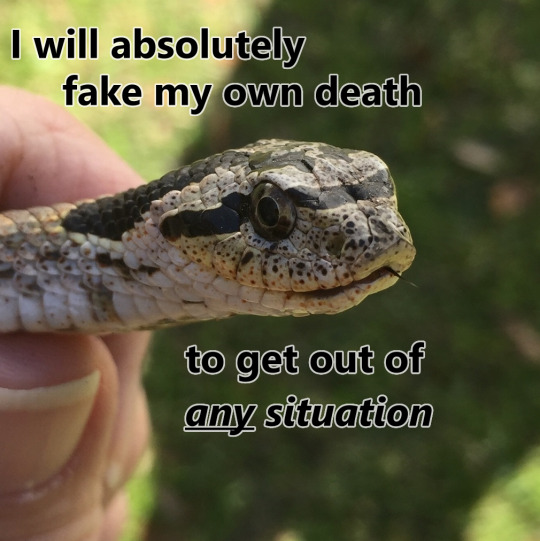
(they’re serious, they’ll do it! – image source)
((I’m actually going to stick the rest of this under a read-more, bc the pictures of the alive-and-physically-fine hognose snakes do kind of look like a legitimately-dead hognose snake, if you don’t know what to look for.
So, uh: cw for a snake being too good at pretending to be dead))
Behold: a series of completely healthy, unharmed snakes!!!

(to help with their self-esteem, we ask that you at least pretend to believe that they are dead – image sources 1, 2, 3, 4)
Honestly, the photos don’t do it justice. Here’s my favourite video of the whole wonderous performance:
undefined
youtube
But to review:
There's writhing! There's dramatic noises! There's flipping onto their back and opening their mouth wide and letting their tongue hang out! There's excreting a combination of intentionally smelly substances!!! Truly a master of the art of being left the hell alone (*^▽^*)

(yep. deeeeefinitely dead. not just faking it. nothing worth eating here! – image source)
Personally, my favourite part of this is how they insist on rolling onto their back, even when they are rolled back onto their stomach.
Seriously, if you try to roll them right-side-up, they will flip back over. It's as though they believe that a good, proper dead snek MUST be on its back, obviously.
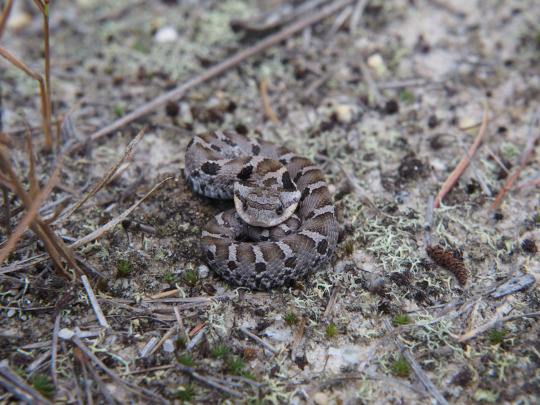
(truly fearsome – image source)
Sadly, the hognose snake may have made itself too scary, according to humans.
Out of fear, these snakes are commonly killed on sight 😔. I once heard someone proudly brag about how they’d killed a dozen cobras! In southern Ontario! Where cobras do not live! This is both extremely frustrating and deeply sad.

(safe enough to hold! although maybe don’t, just because this snake IS probably experiencing mortal fear, which is not a good feeling – image source © Dean Stavrides)
So just to highlight: hognose snakes are completely harmless. They’re just pretending to be fearsome!
(not that people should be killing venomous snakes either, imo. Let the danger noodles LIVE THEIR LIVES)
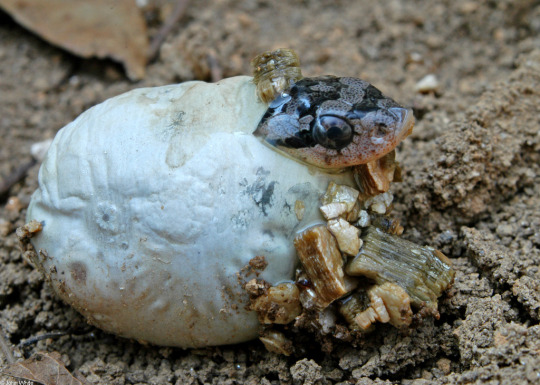
(i is baybee, pls do not hurt me – image source)
And now some bonus facts to help raise us out of that downer:
Hognose snakes are toad specialists! Their favourite food is toads, which is unusual, because toads are poisonous. Hognose snakes deal with this by force of will and also, at least two amino acid substitutions, maybe (Mohammadi et al. 2016). Possibly a few other things help with this, also (Feldman et al. 2016).
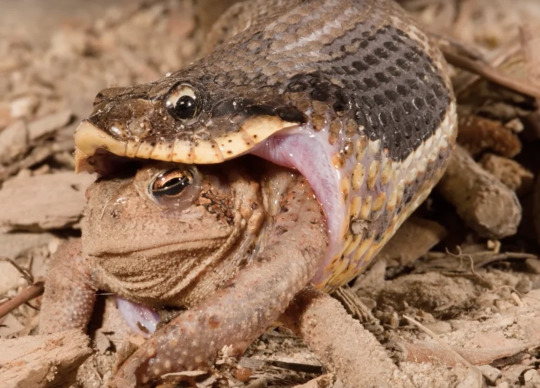
(is snek eat toad? or does toad wearing cape of snek? impossible to tell, really – image source)
Also, I have a confession: hognose snakes... are venomous. Technically.

(itty bitty little fangs at the veeeeery back of their mouth! – image source)
They are known as rear-fanged snakes, which means they have fangs aaaall the way at the back of their mouth. The venom they produce seems to be toad-specific, and is considered to be harmless to humans unless you happen to have an allergy but that's the exception rather than the rule

(the two hognose species. They are both baybee, but in different ways actually there might be more than two species but these are the two i’ve actually learned about so ALL WELL – image source)
Also, hognose snakes are big cowards NOT aggressive and I've never even heard of anyone getting bit by a one (outside of one feeding mishap, which we can all agree was an ACCIDENT).
The series of events that would need to occur for you to be envenomated are so unlikely and bizarre that I assume you would have to be TRYING to get bit.
This has been Fun Fact Friday, bringing you the forbidden noodly boys to try and keep them a little more safe!
.....................................................................
Sources, because I know me and SO DO YOU:
Averill-Murray, R. C. (2006). Natural history of the western hog-nosed snake (Heterodon nasicus) with notes on envenomation. Sonoran Herpetologist, 19(9), 98-101.
Buchanan, Scott W.; Timm, Brad C.; Cook, Robert P.; Couse, Richard; Hazard, Lisa C. (2017). Spatial ecology and habitat selection of eastern hognose snakes. The Journal of Wildlife Management, 81(3), 509–520. doi:10.1002/jwmg.21218
CHS: Canadian Herpetological Society https://canadianherpetology.ca/species/species_page.html?cname=Eastern%20Hog-nosed%20Snake
COSEWIC. 2021. COSEWIC assessment and status report on the Eastern Hog-nosed Snake Heterodon platirhinos in Canada. Committee on the Status of Endangered Wildlife in Canada. Ottawa. xi + 45 pp. https://www.canada.ca/en/environment-climate-change/services/species-risk-public-registry/cosewic-assessments-status-reports/eastern-hog-nosed-snake-2021.html
Cunnington, G. M., & Cebek, J. E. (2005). Mating and nesting behavior of the eastern hognose snake (Heterodon platirhinos) in the northern portion of its range. The American midland naturalist, 154(2), 474-478.
Feldman, C. R., Durso, A. M., Hanifin, C. T., Pfrender, M. E., Ducey, P. K., Stokes, A. N., ... & Brodie Jr, E. D. (2016). Is there more than one way to skin a newt? Convergent toxin resistance in snakes is not due to a common genetic mechanism. Heredity, 116(1), 84-91.
Jared, C., Luiz Mailho‐Fontana, P., & Maria Antoniazzi, M. (2021). Differences between poison and venom: An attempt at an integrative biological approach. Acta Zoologica, 102(4), 337-350.
Liu, C., Chen, Y., Zheng, Y., Bo, J., Yang, C., Xu, S., & Zhang, S. (2022). Wear Resistance Improvement of Keeled Structure and Overlapped Distribution of Snake Scales. Journal of Bionic Engineering, 1-11. Citing abstract.
Mohammadi, S., Gompert, Z., Gonzalez, J., Takeuchi, H., Mori, A., & Savitzky, A. H. (2016). Toxin-resistant isoforms of Na+/K+-ATPase in snakes do not closely track dietary specialization on toads. Proceedings of the Royal Society B: Biological Sciences, 283(1842), 20162111.
Nature Conservancy of Canada: https://www.natureconservancy.ca/en/what-we-do/resource-centre/featured-species/reptiles-and-amphibians/eastern-hog-nosed-snake.html
Plummer, M. V., & Mills, N. E. (1996). Observations on trailing and mating behaviors in hognose snakes (Heterodon platirhinos). Journal of Herpetology, 30(1), 80-82.
Rouse, Jeremy D.; Willson, Robert J.; Black, Ron; Brooks, Ronald J. (2011). Movement and Spatial Dispersion of Sistrurus catenatus and Heterodon platirhinos: Implications for Interactions with Roads. Copeia, 2011(3), 443–456. doi:10.1643/ce-09-036
Seburn, D. 2008. Recovery Strategy for the Eastern Hog-nosed Snake (Heterodon platirhinos) in Canada. Species at Risk Act Recovery Strategy Series. Parks Canada Agency, Ottawa. vi + 24pp.
Schwartz, V. & D. Golden (2002). Field Guide to Reptiles and Amphibians of New Jersey. New Jersey Division of Fish and Wildlife
VHS: Virginia herpetological society http://www.virginiaherpetologicalsociety.com/reptiles/snakes/eastern-hog-nosed-snake/eastern_hognose_snake.php#:~:text=Heterodon%20is%20derived%20from%20the%20Greek%20words%20heteros,meaning%20%22broad%20or%20flat%22%20and%20rhinos%20meaning%20%22snout%22
Young, R. A. (1992). Effects of Duvernoy's gland secretions from the eastern hognose snake, Heterodon platirhinos, on smooth muscle and neuromuscular junction. Toxicon, 30(7), 775-779. https://doi.org/10.1016/0041-0101(92)90013-U
Young, B. A., & Morain, M. (2003). Vertical burrowing in the Saharan sand vipers (Cerastes). Copeia, 2003(1), 131-137.
SARA: threatened https://www.canada.ca/en/environment-climate-change/services/species-risk-public-registry.html
#hognose snake#snakes#biology#fun facts#fun fact friday#science#sciblr#science side of tumblr#STEM#adhd in STEM#zoology#ecology#Herpetology#snake#i love these guys so so much#there's more but its late#also this is late#i wrote it last week but then stuff happened#well#i wrote most of it last week#some of it was written in 5 minutes of frenzied keyboard slamming#depression is STILL HERE#but im doing my best#also yes i know it's saturday but LET ME LIVE#Youtube
2K notes
·
View notes
Note
Fun Facts that could be mine, you say? I'm demanding a refund if it isn't as fun as the advertisement seemed to make it...
No pressure, huh?
Alright, then, go big or go home, I guess. Today You Learned about an architectural conspiracy theory.
Star forts!

Or bastion forts, as Wikipedia calls them.
So if you've looked at fortresses throughout history, you may notice that there came a point in which Europeans started building fortresses like this, instead of like standard castles with rectangular or circular walls. The change was the advent of gunpowder, or rather, the wide usage of gunpowder on the battlefield and in sieges. See, if you're defending a fort, and someone comes with cannons... well, they can blow the wall apart quite easily. You can also try planting explosives at the base of the walls.
Walls like this, which were thicker and lower, allowed you to have less of a target, a more difficult wall to blast through, and gave your defenders a chance to fire down at people who walked up to the wall in a way that you can't do if you don't have a good angle on them.
Or something. I don't know, I'm not a tactician. Anyway there a butt-ton of these around the world. They fell out of favor as gunpowder weapons evolved, so they became obsolete. That's not the wild part. The absolutely wild part is that there are people who have conspiracy theories about these things.
So as pointed out in this article, there's a website called starforts.org, which claims that these fortresses are not, as they appear to be, structures built for gunpowder warfare, but are actually the remains of a long-lost civilization that spanned the globe before recorded history.

I promise that I am not making this up.
The claims are things that are obviously nonsense--that these somehow harness electricity somehow to make them ancient power generators that we've somehow forgotten how to turn on, or that they're used to transport people around the globe. These whackjobs insist that Europeans didn't build these--they found them out there in the wild, or something, and built over them to disguise how old they really are. There's one assertion that they're actually grown like living organisms rather than built like... buildings.
[Ohmygoshweareadoomedspecies]
Obviously, no, this is bunk. No, it's more than bunk, it's remarkably stupid. We have records of these forts being built. You can look up why they were built the way they were! Heck, you can visit them and see their foundations and walls and see that they're clearly not organic, or ancient, or power generators, or whatever!
They look really cool, though.

#Today You Learned#Fun Fact Friday#star forts#forts#architecture#conspiracy theories#New Age#stupid people
133 notes
·
View notes
Note
FUN FACT FRIDAY!!! What’s one fun fact about you that you haven’t shared with us yet?
Let’s see about 15 months ago I messaged @makeitastrength at random. I was annoyed with someone in the fandom being extra negative in S5. When there was nothing to be negative about. It rubbed me the wrong way and I wanted someone to vent with. So I messaged her. D was lovely and messaged me back. Sharing my annoyance about it. Ever since that first message we haven’t gone a single day without talking to each other.
Truly become one of my best friends. So this is where the fun fact kicks in. As we branched out into non fandom convos. We realized how much we had in common, we like to joke we were separated at birth, share a Chenford Brain. One day she sent me this Chenford map link. Which was really cool. Had a pin with where all the fans who participated lived. I clicked on Colorado and saw one other person lived there that was a shipper.
Made a comment to her about it wondering who that person was. It was D. Not only do we live in the same state. We live in the same city and are only 5 minutes away from each other. We sent each other our views from our places. We both recognized scenery and landmarks and couldn’t believe how close we are to each other. Which with everything else we had in common honestly made sense we would have this too. LOL So I hope this fits the fun fact you were looking for haha
We wanted to coordinate answers on this since we both got the ask. So This is D’s reply here :)
28 notes
·
View notes
Text
Fun fact friday
Venus's years are shorter than its days, with a year being ~225 earth days long and a day on venus being ~243 earth days long
49 notes
·
View notes
Text
Credit: sportsgirlclub
Fun fact Friday!
(🎥: @carleecalf and @sportsgirlsclub on TT and IG)
( good news is that they probably do know who we are )
#sports for the girls#professional athletes#hockey#nhl#hockey players#I always wonder if they do check out social#tyler seguin#jack hughes#luke hughes#quinn hughes#trevor zegras#I wonder if they know about fan fics#I still have a Instagram post about Tyler Seguin and I think I @ him#just be delusional#its good to know#fun fact friday
24 notes
·
View notes
Text
Fun Fact Friday
Andromeda is on a collision course with the Milky Way.
It's also the largest galaxy in our local group!
26 notes
·
View notes
Text
Fun Fact!
Polaris, or more specifically Polaris Aa, is a gigantic star, nearly 40 times as large as the Sun and over a thousand times brighter. It is orbited by another star, Polaris Ab, a fairly normal, Sunlike star at roughly Uranus’s distance. Neither of these stars would be good conditions for planets.
But the system has a third star, Polaris b, that is just an ordinary, sunlike star and orbits the As at a 2400 AU distance. It’s entirely plausible there could be planets around it, even perhaps habitable ones.
Source: Quora
#celestial same picverse#celestial-same-picverse#celestial same picture#polaris posts#polaris#fun fact friday
23 notes
·
View notes
Text
FUN FACT
JUPITER IS THE OLDEST PLANET IN THE SOLAR SYSTEM
(Extra little fact: it was created from the leftover particles of the suns formation)
25 notes
·
View notes
Text
it's fun fact friday! does anyone want to share a fun fact?
116 notes
·
View notes
Text
Crab Fact: A crab can not hold your hand :(
528 notes
·
View notes
Text
Fun Fact: Starfish get around using a hydraulic system!
I want to start off by saying: you may have heard that starfish have sea water instead of blood! This is not true!
Before I explain, let me point out this little dot that every starfish has (and I SWEAR that this is relevant)

(It’s like they all have lil’ buttons on! 1, 2, 3)
This little spot is known as a madreporite, from Italian madre (”mother”) + Latin poro (”pore”).
What is it? Well, to over-simplify:
The madreporite is basically a pressure valve for the insides of the starfish. It lets water in and out of its water vascular system as needed. In order to prevent debris and sea life and other non-desirables from getting inside the starfish, the madreporite filters the water that it takes in.
this is what the madreporite looks like up close:

(Name origin: apparently someone saw that and thought “huh, that kind of looks like madrepore coral, but tiny! They... weren’t wrong.)
Now, you may look at the name “water vascular system” and think “hey, I know ‘vascular’! That's related to blood!” This is a reasonable misunderstanding.
While in humans, the circulatory system is part of a vascular system (along with our lymphatic system) in the starfish’s water vascular system, seawater is NOT analogous to blood in a circulatory system. Or, well, it’s complicated, because it does do some things that are similar to a mammalian circulatory system, such as transporting certain types of immune cells, but still (source: Ferguson 1966)
Instead, these seawater-filled tubes are used for things such as the movement of starfish arms (and their little tube feet), which in turn allows them to move around their environment, find and consume food, and stick to surfaces. Mammals generally don’t use their circulatory systems in this way (if I am wrong about this, PLEASE let me know, as that would be absolutely WILD).

(diagram of a starfish’s water-vascular system, revealing the starfish’s final form: some sort of fidget toy, I think)
I admit that “starfish use seawater instead of blood” is a much more attention-grabbing headline, but it’s not true, and it’s also kind of sad, because the water-vascular system is really cool without the misinformation!
(before you ask, yes, this entire post was prompted by one (1) person saying something that was WRONG, and that person may or may not have been related to me 😤😭😭😭😭😭)
The water-vascular system is, essentially, a hydraulic system. By adding and expelling water, as well as opening and closing internal channels via muscle contractions, starfish can create positive and negative pressure within their bodies. This allows them to “flex” their tube feet in surprisingly complex ways, among other functions.
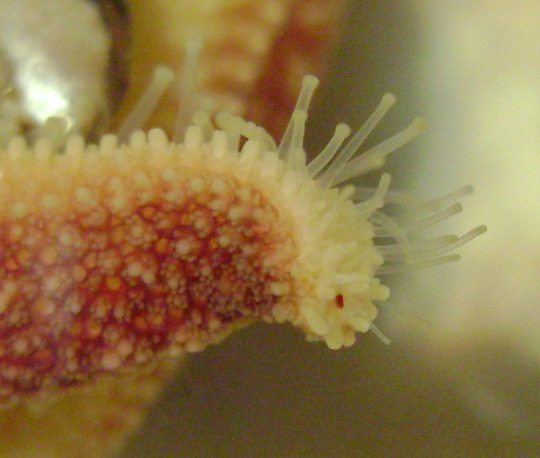
(these^ are a starfish’s “tube feet”. They are little structures with suckers on the ends. If you’ve ever held a starfish in your hands, you probably felt these feet holding onto you. They have a surprising amount of strength!)
You can imagine this sort of like how a whacky inflatable tube man uses air pressure to straighten up and fall down, except with hundreds in one connected, complex system (and also the pressure is more tightly controlled in order to prevent all that flailing, and also to allow fine control required for things like ripping open a mollusc shell).

(I always imagine this when looking at starfish tube feet. And now, maybe you will too! join me. 1, 2)
The confusion regarding starfish blood being seawater is understandable, but in the end it’s essentially a misunderstanding.
Plus, starfish have coelomic fluid, which is honestly more analogous to blood.
Coelomic fluid is, basically, the fluid that fills the starfish’s body cavity between all of its organs and such, facilitating nutrient transport, gas exchange, and overall being more blood-like than the water-vascular system in general (Andradre et al. 2021).
And ok, technically the liquid part of coelomic fluid comes from seawater, ultimately, but that would be like saying I, a human, use tap water for blood. And, ok, yes, there is water in my blood, and that water came from the tap, but no one would say that I have tap water instead of blood! Except my brother but he also says trigonometry doesn’t exist so we will be ignoring his opinion at this time.
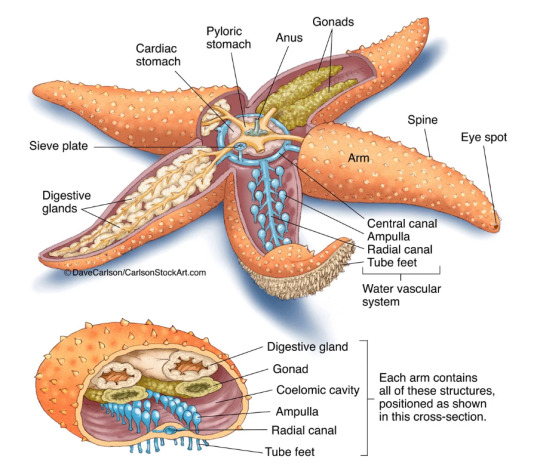
(a more detailed diagram than the one before. The coelomic fluid is found in the coelomic cavity! Also, as a bonus, you now know where a starfish’s anus is! Enjoy this new knowledge next time you look at a starfish! source: x)
Starfish aren’t the only animals with a water vascular system and a madreporite. They can also be spotted in other echinoderms, such as sea urchins, sand dollars, and sea cucumbers (although in the sea cucumber the madreporite is inside the animal, so you probably won’t see it in the wild).

That said, starfish have my favourite madraporites, because I think they look like little badges. They all win the award of being lil friends (and also keystone species that are essential to many marine ecosystems. So.)
This has been Fun Fact Friday, telling you all about wacky lil friends who have funny little feet and DO NOT HAVE SEAWATER INSTEAD OF BLOOD!
I will do battle with my sibling later, as is tradition
Sources under Read More:
Andrade, C., Oliveira, B., Guatelli, S., Martinez, P., Simões, B., Bispo, C., ... & Coelho, A. V. (2021). Characterization of coelomic fluid cell types in the starfish Marthasterias glacialis using a flow cytometry/imaging combined approach. Frontiers in Immunology, 807.
Ferguson, J. C. (1966). Cell production in the Tiedemann bodies and haemal organs of the starfish, Asterias forbesi. Transactions of the American Microscopical Society, 200-209.
Mao, S., Dong, E., Zhang, S., Xu, M., & Yang, J. (2013, July). A new soft bionic starfish robot with multi-gaits. In 2013 IEEE/ASME International Conference on Advanced Intelligent Mechatronics (pp. 1312-1317). IEEE.
#biology#science#stem#fun fact friday#science side of tumblr#animals#starfish#marine biology#there are many benefits to being a marine biologist#such as knowing the location of a starfish's butthole
1K notes
·
View notes
Text
Fun Fact! Crosses!
I am not around, this is a queued Fun Fact! Don't send me requests! I won't see them!
Easter is coming up, so let’s talk about different kinds of crosses! You’ve probably seen most of these before, especially if you’re Catholic, but maybe you didn’t know the names!
Of course, most Christians are familiar with the Latin Cross:

That’s the classic one, of course.
The Greek Cross, with equal lengths on each bar:

Also a classic!
The Patriarchal Cross, which you see a lot in Orthodox churches:

The extra bar towards the top represents the ‘INRI’ sign Pilate posted on the Cross.
The Papal Cross:

I’m not actually sure what the deal with that one is.
The Chi Rho:

This takes the two Greek letters, ‘Chi’ and ‘Rho’ (first two letters of ‘Christos’ in Greek), and combines them.
The Jerusalem Cross, used in the Kingdom of Jerusalem in the Crusades:

I *believe* it represents how Jerusalem was believed to be the center of the world, and the crosses in the corners represent the four corners of the world? I think, anyhow.
The Tau Cross:

Also called Saint Anthony’s Cross, as it’s associated with Saint Anthony of Egypt. It’s also got Franciscan associations!
Cross of Saint James:

Big in Spain, obviously, where Saint James the Greater is quite popular. It’s the symbol of the Order of Santiago (Saint James).
Celtic Cross, which you see a lot in Irish stores as knick-knacks, though they’re also from Scotland and Wales:

Obviously modeled after those stone crosses you’ll see carved in the British Isles.
The Ankh, which Coptic Christians sort of grabbed from Egypt:

This was originally an Egyptian symbol for ‘life’, unrelated to the Cross as we know it in the original context.
The Maltese!

The symbol of the Knights of Saint John and the Order of Hospitallers! And obviously, the island of Malta.
And the Marian Crosses:


It combines the Latin Cross with the letter ‘M’, to emphasize how Mary was at the Crucifixion.
Hope this was something that you didn’t know!
116 notes
·
View notes
Text
Fun fact friday: stars can just be gone and we wouldn’t know because of how light works or something
16 notes
·
View notes
Text
It is OC Fun Fact Friday:
Reblog this post if you want people to come into your inbox and dump their fun/funny facts about their OCs. Do it. Inundate me with Knowledge.
#gw2#guild wars 2#Fun Fact Friday#gw2 oc#guild wars 2 oc#guildwars2#guildwars#guild wars#sylvari#norn#asura#charr#gw2 human
64 notes
·
View notes
Text
Fun fact Friday:
Give us a random fun fact about a character/setting/etc.
Thanks so much for the tag @verba-writing! Now I just need to think of a fun fact...
There's a pub in The Mechanics of Magic that Roy visits in chapter 30 that is based off an actual London pub (and former Victorian gin palace) called the Viaduct Tavern, that was opposite my old office. Look how pretty it is!

I think chapter 30 might actually be my favourite chapter in the whole book, and not just for the location :P
I'll tag @teacupsandstarlight @eccaiia and @dyrewrites if you want to play!
11 notes
·
View notes